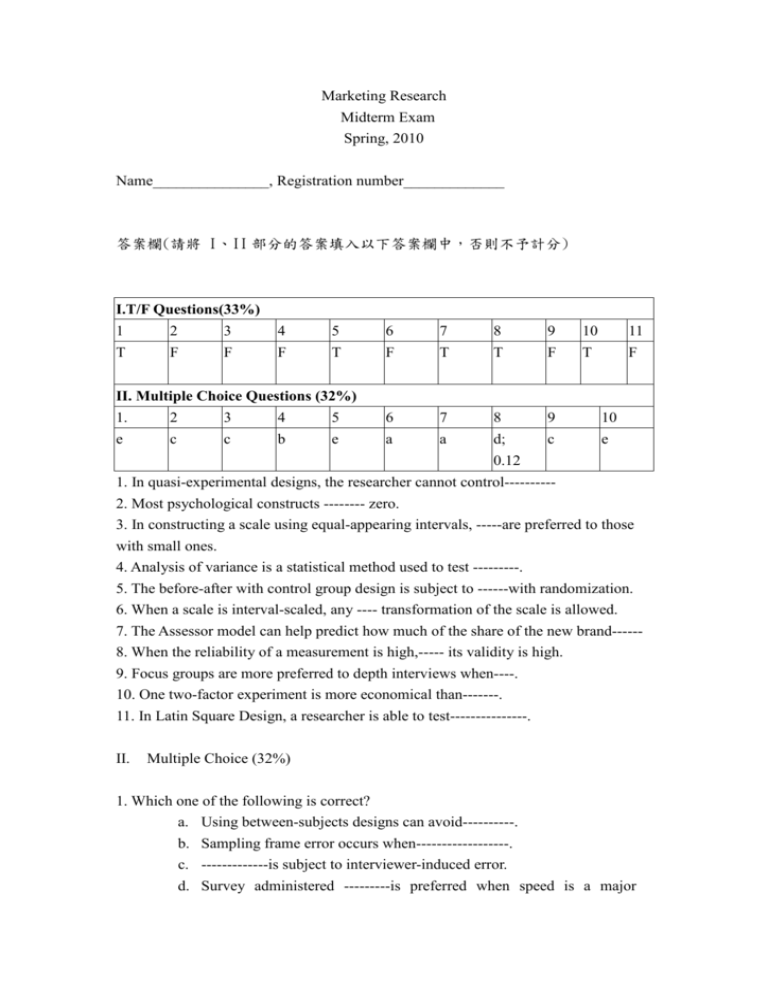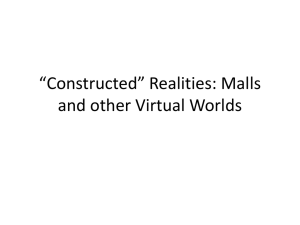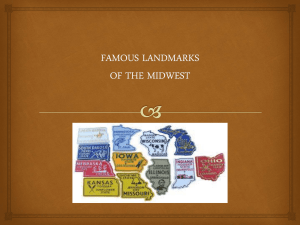Marketing Research Midterm Exam Spring, 2010
advertisement

Marketing Research Midterm Exam Spring, 2010 Name_______________, Registration number_____________ 答案欄(請將 I、II 部分的答案填入以下答案欄中,否則不予計分) I.T/F Questions(33%) 1 2 3 4 5 6 7 8 9 10 11 T F F F T F T T F T F II. Multiple Choice Questions (32%) 1. 2 3 4 5 6 7 8 9 10 e c c b e a a d; 0.12 c e 1. In quasi-experimental designs, the researcher cannot control---------2. Most psychological constructs -------- zero. 3. In constructing a scale using equal-appearing intervals, -----are preferred to those with small ones. 4. Analysis of variance is a statistical method used to test ---------. 5. The before-after with control group design is subject to ------with randomization. 6. When a scale is interval-scaled, any ---- transformation of the scale is allowed. 7. The Assessor model can help predict how much of the share of the new brand-----8. When the reliability of a measurement is high,----- its validity is high. 9. Focus groups are more preferred to depth interviews when----. 10. One two-factor experiment is more economical than-------. 11. In Latin Square Design, a researcher is able to test---------------. II. Multiple Choice (32%) 1. Which one of the following is correct? a. Using between-subjects designs can avoid----------. b. Sampling frame error occurs when------------------. c. -------------is subject to interviewer-induced error. d. Survey administered ---------is preferred when speed is a major concern. e. None of the above. 2. Which one of the following about descriptive research is False? a. The major emphasis is on determining --------------b. It aims at making predictions such as ---------likely to go on to graduate school. c. The general objective is to gain-------------. d. The researcher should develop ---------before data collection. e. It requires a clear specification of ---------------of the research. 3. For long reference periods which of the following is False? a.. Telescoping error is---------. b. Recall loss is----------. c. Telescoping error may-------------. d. The two effects may be---------. 4. Which of the following is NOT true when a scale is a ratio scale? a. Transformations of the form-----------. b. The scale is--------------- of the form y=a+bx. c. If a is greater than b and----------, then a is greater-----------. d. The -------is a permissible measure of central tendency. e. After permissible transformations, ----------------will be preserved. 5. Which one of the following is correct? a. Nonsampling error can---------------. b. -----------------occurs when the response rate is low. c. Survey administered -----is subject to interviewer-induced error. d. Response error occurs when----------- is low. e. None of the above. 6. ------------as typically applied is a measure of a. the internal consistency of the scale. b. relatively stable characteristics of the individual which affect his score c. the simultaneous correlations of all the items. d. -----------and equivalence e. none of the above 7. Which of the following is true? a. --------------in both construction and use stages. b. For both Thurstone indicate-----------------. and Likert scales, respondents are asked to c. Statements are classified as being -------------with equal-appearing intervals and summated rating scales. d. a and b. e. a, b and c. 8. (5%) Suppose that you are asked to estimate the proportion of population who has used marijuana during the past year. In order to let subjects feel free to answer honestly, you decide to use randomized response model where the respondents select question A or B to answer by flipping a coin, say answering A if head occurs and answering B otherwise. Suppose a sample of 1000 subjects has been given a card with two possible questions:-------------------------------------- The results show that there are 100 subjects who respond “yes” in the whole sample. Suppose that according to census data, 8 percent ---------“yes”. Which one of the following is correct? a. There is no way that the researcher can estimate the proportion of subjects who respond “yes” to question A, given that he does not know which question each subject answers. b. The researcher may well replace question B by another question such as “Do you consider price as the most important factor when buying computers?” and ------------c. The randomized response model is most useful when the question to be addressed is-------. d. None of the above. The proportion of subjects who respond “yes” to question A is estimated as (e). III. Essays (35%+Bonus 10%) III Essays 1. (5%) Suppose that a consumer-product manufacturer uses the ASSESSOR model to estimate the market share of a new product, denoted by x1. The manufacturer is also concerned about the possible cannibalization effect of this new product on the sales of its current product, denoted by x0. It is estimated that the evoked set proportion for this new product is about 0.3, given the planned $10 million annual national advertising spending. Moreover, for those subjects who evoke the new product, ----------------is estimated to be 0.4, using the preference model. Suppose that before the introduction of the new product, -------------------be 0.5. Estimate the new market share for the old product, x0 after the introduction of the new product. Also estimate the cannibalization effect of product x1 on product x0. Sol. The new market share for x0 equals 0.3*0.4+(1-0.3)*0.5=0.47. The cannibalization effect of x1 on x0 equals 0.5-0.47=0.03. 表 1 2 3 4 5 Total N A .67 .11 .11 .00 .11 1.00 90 C1 .11 .89 .00 .00 .00 1.00 90 二 B1 .22 .00 .78 .00 .00 1.00 90 表 B2 .00 .00 .11 .89 .00 1.00 90 C2 .00 .00 .00 .11 .89 1.00 90 B2 .00 .00 .50 .50 .00 1.00 30 C2 .00 .00 .00 .00 1.00 1.00 30 B2 .22 .78 .00 .00 .00 1.00 80 C2 .56 .11 .22 .11 .00 1.00 80 三 15% of the sample 1 2 3 4 5 Total N A .00 .00 .50 .50 .00 1.00 30 C1 .50 .50 .00 .00 .00 1.00 30 B1 .50 .50 .00 .00 .00 1.00 30 表 1 2 3 4 5 Total N A .00 .00 .00 .00 1.00 1.00 80 四 40% of the sample C1 B1 .00 .22 .00 .11 .11 .67 .89 .00 .00 .00 1.00 1.00 80 80 2. Judge whether it is true or false for each of the following statements. (T)(i) AB company should introduce B1 rather than B2 according to the above tables. (Remark: The following computations are based on some implicit assumptions such as that consumers will buy the brand they ranked first. The incremental shares associated with B1: From defending A: 0.22*45%=9.9%; From attracting customers from C1: 0.5*15%=7.5%; From attracting customers from C2: (0.22+0.11)*40%=13.2%. Thus the introduction of B1 will increase the market share of AB company by 20.7%, and it may also prevent the share loss of A to C1 (by 9.9%). In contrast, B2 can only attract 17.6% of C2 customers (i.e., (0.22+0.22)*0.4=0.176) and increase AB company’s market share by 17.6%, which is less than 20.7%.) (F) (ii) AB company should introduce both B1 and B2 regardless of the number of brands its dealers usually carry. (T)(iii) The new formulation B1 can attract customers from competitor C1 better than B2 can. (F)(iv) AB company will be more concerned about cannibalization problem when introducing B1 instead of B2. (It seems that those who rank B1 first rank C1 second, which means the introduction of B1 attract customers from C1 but not from A (without B1, those who prefer B1 will buy C1 instead of A). The so-called cannibalization problem is not relevant in the presence of competitor C1.) 3. Without Disclaimer Ad F Ad G With Disclaimer Total Mean West mall 3.2 3.25 2.9 2.95 12.3 3.075 East mall 3.1 2.95 3.4 3.25 12.7 3.175 West mall 1.85 2.0 2.15 2.3 8.3 2.075 East mall 2.15 2.3 1.85 2.0 8.3 2.075 10.5 10.3 10.5 41.6 Total Mean 10.3 2.6 2.6 2.6 Based on John’s and Mary’s analyses, for each of the following statements, judge whether it is true or not. (F)(i) It is good to focus on the data collected from one mall so that the effect of independent variables can be identified by removing variations across malls; furthermore, the result can be generalized to other malls. (T ) (ii) Based on John’s analysis, the effects of disclaimer depend on the type of ad and there exists a significant interaction effect between type of ad and disclaimer. (T) (iii) Mary, by using data from both the West and East malls, can apply her research results to both geographic areas. (T) (iv) Based on John’s analysis on data from West mall, the effects of disclaimer depend on the type of ad. (T) (v) The factorial designs can be used with completely randomized designs as well. However, when the effects of disclaimer depend on which mall (block) test units are from, the additivity assumption of block effects is violated. ( F)(a) The order of presentation of the two ads should have been kept constant across malls in order to measure how respondents’ preferences toward different ads differ. ( F)(b) When focusing on group C, the order of ads is the same across different shopping malls, thus making the effect of disclaimer and the effect of ad be adequately measured. (F )(c) Between-subjects designs, unlike within-subjects designs, cannot eliminate systematic errors. ( F) (d) The effect of disclaimer on ad evaluation had better be tested by comparing the three groups where the order of ads is not constant across groups. ( F)(d) The causal effect of shopping mall on ad preferences can be examined in a Latin-square designs despite the shopping center at which each subject was selected could only be taken as given and could not be controlled and manipulated by a researcher.




